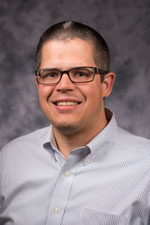Tenhaeff’s CAREER award will develop way to use gels as battery electrolytes
 In the quest for safer lithium ion batteries for vehicles and for grid storage of renewable electricity, considerable research has focused on using solid electrolytes.
In the quest for safer lithium ion batteries for vehicles and for grid storage of renewable electricity, considerable research has focused on using solid electrolytes.
They would be much less combustible than the liquid electrolytes currently used. But solid electrolytes are notoriously difficult to integrate within existing battery designs, especially within the porous electrodes where charge is stored.
Wyatt Tenhaeff, an assistant professor of chemical engineering who specializes in electrochemical energy storage, has received a CAREER award from the National Science Foundation to pursue a compromise.
Gels, though not as safe as solid electrolytes, would be significantly safer than flammable liquid electrolytes currently used.
And though gels also are difficult to infuse in cathodes, Tenhaeff believes he can overcome that obstacle by developing a novel chemical vapor deposition (CVD) process. It would infiltrate the pores with a polymeric material that absorbs liquid, filling the pores with a gel electrolyte.
“That’s going to lead to enhanced safety,” Tenhaeff says.
Here’s why. When a lithium ion battery with liquid electrolytes short circuits -- because of an accident or other cause – heat is generated. As the cell temperature rapidly increases, liquid electrolytes can vaporize, then combust.
“So, we’re widening the window of safety.”
A major part of the project will be refining the CVD process, which could also be applied to other chemical processes where rapid polymer film deposition is needed – such as corrosion protection coatings and optical coatings.
Tenhaeff is looking forward to incorporating elements of his project into the Department of Chemical Engineering’s undergraduate curriculum, so the students can benefit from research experience.
“The technique that I use basically incorporates all the core concepts of chemical engineering,” he says.
His plan is to develop an instructional polymer CVD system that could be used in two classes, one of which focuses on conducting scripted, short-term experiments, the other a senior design course in which teams of students work on a semester long project.
“They will help us develop new technologies and processing techniques, while giving students important hands-on experience with state-of-the-art vacuum processing capabilities” he says. “So, I’m really excited about this.”
